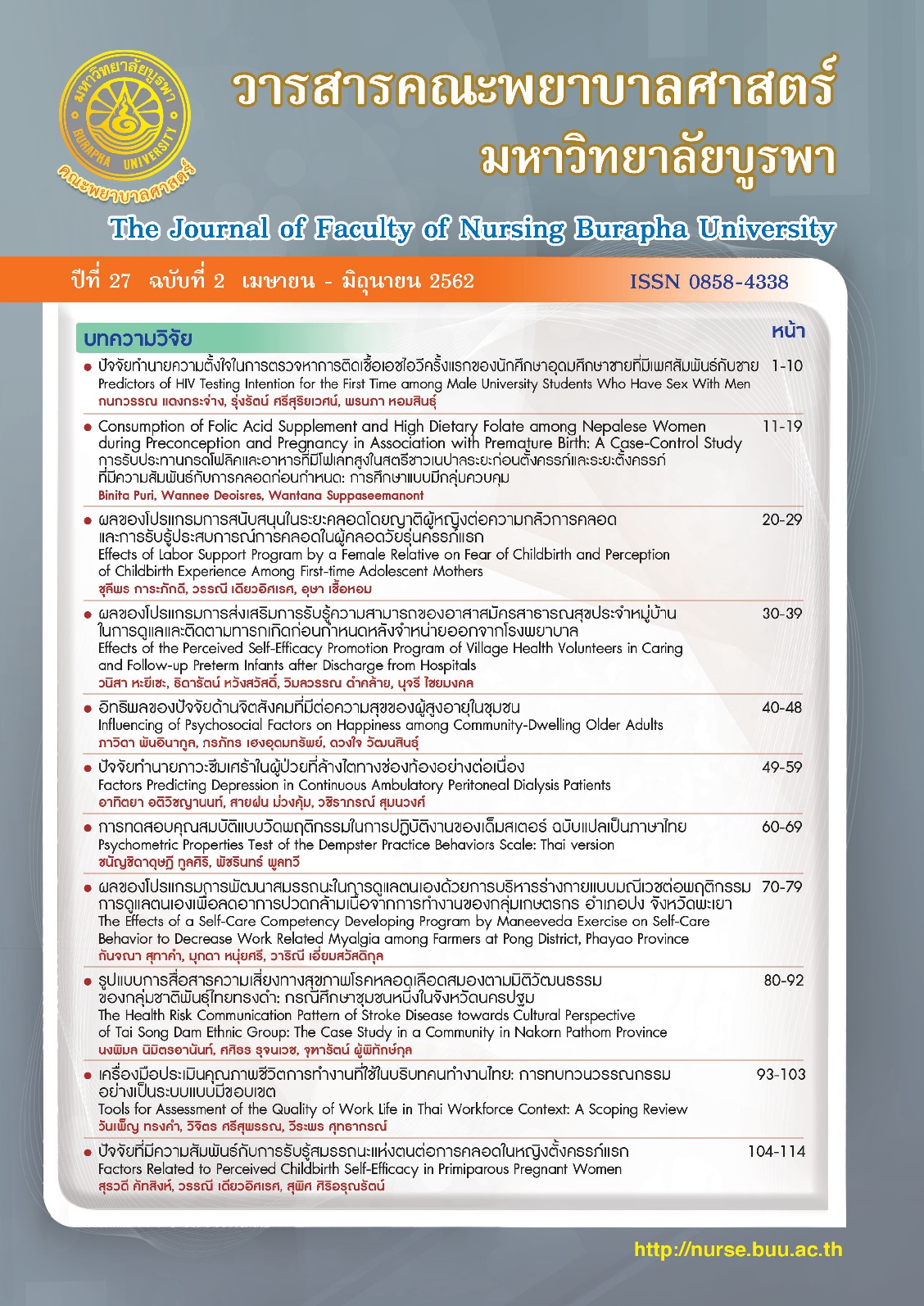การรับประทานกรดโฟลิคและอาหารที่มีโฟเลทสูงในสตรีชาวเนปาลระยะก่อนตั้งครรภ์และระยะตั้งครรภ์ที่มีความสัมพันธ์กับการคลอดก่อนกำหนด: การศึกษาแบบมีกลุ่มควบคุม
คำสำคัญ:
กรดโฟลิกเสริม, สารอาหารที่มีโฟเลทสูง, ระยะก่อนตั้งครรภ์, ระยะตั้งครรภ์, การคลอดก่อนกำหนดบทคัดย่อ
บทคัดย่อ
การวิจัยแบบแบบมีกลุ่มควบคุมครั้งนี้มีวัตถุประสงค์เพื่อศึกษาการรับประทานกรดโฟลิกเสริมและอาหารที่มีโฟเลทสูงในสตรีชาวเนปาลระยะก่อนตั้งครรภ์และระยะตั้งครรภ์ที่มีความสัมพันธ์กับการคลอดก่อนกำหนด กลุ่มตัวอย่างคัดเลือกแบบสะดวกจำนวน 84 คน เป็นมารดาที่คลอดบุตรก่อนกำหนด (จำนวน 42 คน) และคลอดบุตรครบกำหนด (จำนวน 42 คน) ที่โรงพยาบาลแห่งหนึ่งในเมืองกาฐมาณฑุ ประเทศเนปาล ในระหว่างเดือนมีนาคม ถึงเดือนเมษายน พ.ศ. 2561 เครื่องมือที่ใช้ในการวิจัยเป็นแบบสอบถามจำนวน 5 ชุดที่ให้กลุ่มตัวอย่างเป็นผู้ตอบเอง ได้แก่ แบบสอบถามข้อมูลทั่วไป แบบสอบถามการรับประทานกรดโฟลิกเสริมในระยะก่อนตั้งครรภ์และระยะตั้งครรภ์ และแบบสอบถามการรับประทานอาหารที่มีโฟเลทสูงในระยะก่อนตั้งครรภ์และระยะตั้งครรภ์ ข้อมูลเกี่ยวกับการคลอดได้จากบันทึกของโรงพยาบาล วิเคราะห์ข้อมูลด้วยสถิติพรรณา การทดสอบที การทดสอบไคสแควร์ และการวิเคราะห์ถดถอยโลจิสติกแบบมัลติเปิล
ผลการวิจัยพบว่า ในระยะก่อนตั้งครรภ์และระยะตั้งครรภ์ สตรีกลุ่มตัวอย่างที่รับประทานอาหารที่มีโฟเลทสูงมากกว่า มีการคลอดก่อนกำหนดน้อยกว่าสตรีที่รับประทานอาหารที่มีโฟเลทสูงน้อยกว่า (OR=.20, 95%CI =.06-.67 และ OR= .53, 95%CI= .32-.92 ตามลำดับ) การรับประทานกรดโฟลิกเสริมมากในระยะก่อนตั้งครรภ์ไม่มีความสัมพันธ์กับการคลอดก่อนกำหนด แต่การรับประทานกรดโฟลิกเสริมมากในระยะตั้งครรภ์มีการคลอดก่อนกำหนดน้อยกว่า เมื่อเทียบกับสตรีที่รับประทานกรดโฟลิกเสริมน้อย (OR=.53, 95%CI= .32-.92) ผลการวิจัยครั้งนี้สนับสนุนผลการวิจัยที่ผ่านมาว่าการรับประทานสารอาหารที่มีโฟเลทสูงในระยะก่อนตั้งครรภ์และระยะตั้งครรภ์ รวมทั้งการรับประทานกรดโฟลิกเสริมในระยะตั้งครรภ์ สามารถลดความเสี่ยงต่อการคลอดก่อนกำหนดได้
เอกสารอ้างอิง
Alfonso, V. H., von Ehrenstein, O., Bandoli, G., & Ritz, B. (2016). The influence of pre-natal supplement initiation on preterm birth among majority Hispanic women in Los Angeles county: The role of nativity. Maternal and Child Health Journal, 20(9), 1861-1868.
Bhandari, S., Sayami, J. T., Sayami, M., Kandel, B. P., & Banjara, M. R. (2014). General health status of women of reproductive age in Nepal. Journal of Nepal Health Research Council, 12(26), 8-13.
Cha, E. S., Kim, K. H., & Erlen, J. A. (2007). Translation of scales in cross-cultural research: Issues and techniques. Journal of Advanced Nursing, 58(4), 386-395.doi:10.1111/j.1365-2648.2007.04242.x
Gautam, P., & Dhakal, R. (2016). Knowledge on preconception care among reproductive age women. Saudi Journal of Medical and Pharmaceutical Sciences, 2(1): 1-6
Grieger, J. A., Grzeskowiak, L. E., & Clifton, V. L. (2014). Preconception dietary patterns in human pregnancies are associated with preterm delivery–3. The Journal of nutrition, 144(7), 1075-1080.
Health Canada (2008). Nutrient value of some common foods. Retrieved from file:///Users/macbook/Downloads/nutrient-value-common-foods.pdf
Kc, A., Wrammert, J., Nelin, V., Ewald, U., Clark, R., & Malqvist, M. (2015). Level of mortality risk for babies born preterm or with a small weight for gestation in a tertiary hospital of Nepal. BMC Public Health, 15, 877. doi:10.1186/s12889-015-2232-1.
Li, Z., Ye, R., Zhang, L., Li, H., Liu, J., & Ren, A. (2014). Periconceptional folic acid supplementation and the risk of preterm births in China: A large prospective cohort study. International Journal of Epidemiology, 43(4), 1132–1139. https://doi.org/10.1093/ije/dyu020
Liu, L., Oza, S., Hogan, D., Perin, J., Rudan, I., Lawn, J. E., & Black, R. E. (2015). Global, regional, and national causes of child mortality in 2000–13, with projections to inform post-2015 priorities: an updated systematic analysis. The Lancet, 385(9966), 430-440.
Liu, X., Lv, L., Zhang, H., Zhao, N., Qiu, J., He, X. & Lerro, C. (2016). Folic acid supplementation, dietary folate intake and risk of preterm birth in China. European journal of nutrition, 55(4), 1411-1422.
Mantovani, E., Filippini, F., Bortolus, R., & Franchi1, M. (2014). Folic acid supplementation and preterm birth: Results from observational studies. BioMed Research International, Volume 2014, Article ID 481914, 8 pages http://dx.doi.org/10.1155/2014/481914.
Nisar, B. S., Dibley, J. M., & Aguayo, M. V. (2016). Iron folic acid supplementation during pregnancy reduces the risk of stunting in children less than 2 years of age: A retrospective cohort study from Nepal. Open Access Human Nutrition Journal, 8(67).
Paudel, P., Wing, K., & Silpakar, S. K. (2012). Awareness of periconceptional folic acid supplementation among Nepalese women of childbearing age: A cross-sectional study. Prev Med, 55(5), 511-513. doi:10.1016/j.ypmed.2012.09.001
Sharif, M. E., Mohamedain, A., Ahmed, A. A., Nasr, A. M., & Adam, I. (2017). Folic acid level and preterm birth among Sudanese women. Maternal health, neonatology and perinatology, 3(1), 25.
Sengpiel, V., Bacelis, J., Myhre, R., Myking, S., Pay, A. S. D., Haugen, M., & Vollset, S. E. (2013). Folic acid supplementation, dietary folate intake during pregnancy and risk for spontaneous preterm delivery: a prospective observational cohort study. BMC Pregnancy and Childbirth, 14(1), 375.
Tabachnick, B. G., & Fidell, L. S. (2007). Using multivariate statistics (5th ed.). Boston, MA: Allyn and Bacon.
World Health Organization. (2012). Daily iron and folic acid supplementation in pregnant women: Guidelines. Retrieved from http://apps.who.int/iris/bitstream/10665/77770/1/9789241501996_eng.pdf
World Health Organization. (2018). Preterm birth, Key facts. Retrieved from http://www.who.int/news-room/fact-sheets/detail/preterm-birth
Zheng, J. S., Guan, Y., Zhao, Y., Zhao, W., Tang, X., Chen, H., & Huang, T. (2016). Pre-conceptional intake of folic acid supplements is inversely associated with risk of preterm birth and small-for-gestational-age birth: a prospective cohort study. British Journal of Nutrition, 115(3), 509-516.





